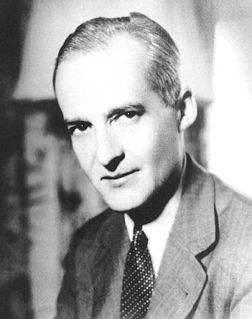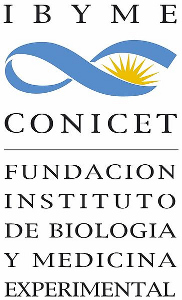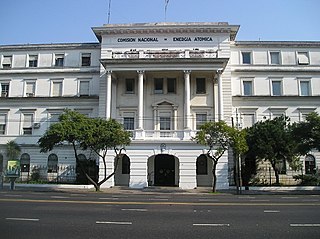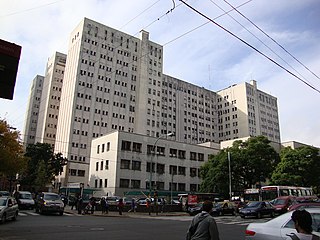This article needs additional citations for verification .(November 2019) |

The Leloir Institute is a non-profit research center in Buenos Aires specializing in biochemistry, cellular biology, molecular biology, and related activities.
This article needs additional citations for verification .(November 2019) |

The Leloir Institute is a non-profit research center in Buenos Aires specializing in biochemistry, cellular biology, molecular biology, and related activities.
The research center was inaugurated in 1947 by way of an initiative of University of Buenos Aires Physiology Professors Bernardo Houssay and Luis Leloir. The project was funded by the philanthropic support of local textile industrialist Jaime Campomar, and Dr. Houssay devoted a share of the proceeds from the Nobel Prize in Physiology he earned that year to the establishment of the institute. Initially located in a belle époque building in the Palermo section of Buenos Aires, the institute was first directed by Dr. Leloir and, following Campomar's death in 1956, it became a recipient of an endowment from both the Rockefeller Institute and the National Institutes of Health, both in the United States. The institute was formally named the Campomar Institute of Research in Biochemistry in 1958, when it was relocated to a utilitarian building belonging to the city's health ministry in the Belgrano section, nearby. [1]

Dr. Leloir's work at the institute on nucleotides and their role in human metabolic pathways earned him the 1970 Nobel Prize in Physiology. This became known as “Leloir's pathway” and was a significant advance for biochemistry. As a consequence of this 1957 discovery, the cause of a congenital disease called galactosemia was first identified; not detected in time, it can cause mental retardation, cataracts and cirrhosis. Numerous other colleagues of his at the institute became well known in their fields, as well. These have included Enrico Cabib, Carlos Cardini, Ranwell Caputto, Alejandro Paladini, and Raúl Trucco, among others. The continued support of the Campomar Foundation allowed the institute to relocate to its current facilities in 1983. [1]
Located in the Caballito section of the city and facing Parque Centenario, the new facilities total over 6,900 m² (74,000 ft²) and include laboratories, teaching facilities, an auditorium and the National Biochemistry Reference Library. It was renamed the Leloir Institute in recognition of its longtime director (who died in 1987), in 2001. That year, the center initiated its program of "repatriation of researchers," in a bid to both incorporate new scientific staff, as well as to help reverse the long-standing brain drain suffered by the Argentine scientific community. [1]
The center maintains numerous cooperation agreements with not only prominent local research centers such as the CONICET and University of Buenos Aires School of Exact Sciences; but also respected international centers, such as Partners Harvard Medical International, the Howard Hughes Medical Institute, Inis Biotech, and the Weizmann Institute. It hosts 24 research teams and 170 scientists, whose varied specialties include neuroscience, cellular biology, oncology, gene therapy, epidemiology, biotechnology and structural biology; among its associated fellows is the recipient of 1984 Nobel Prize in Physiology, Dr. César Milstein. Construction started on the institute's new annex in 2007, consisting of 2,900 m² (31,000 ft²) of space for imaging, as well as for expanded research on cell cultures and biophysics. These investments continue the Leloir Institute's tradition as a leader in science and technology in Argentina. [1]
Bernardo Alberto Houssay was an Argentine physiologist who, in 1947, was a co-recipient of a Nobel Prize for Physiology or Medicine for his discovery of the role played by pituitary hormones in regulating the amount of blood sugar (glucose) in animals. He was the first Argentine Nobel laureate in the sciences. He shared the prize with Carl Ferdinand Cori and Gerty Cori, who won for their discoveries regarding the role of glucose in carbohydrate metabolism).

Luis Federico Leloir was an Argentine physician and biochemist who received the 1970 Nobel Prize in Chemistry for his discovery of the metabolic pathways in lactose. Although born in France, Leloir received the majority of his education at the University of Buenos Aires and was director of the private research group Fundación Instituto Campomar until his death in 1987. His research into sugar nucleotides, carbohydrate metabolism, and renal hypertension garnered international attention and led to significant progress in understanding, diagnosing and treating the congenital disease galactosemia. Luis Leloir is buried in La Recoleta Cemetery, Buenos Aires.

The University of Buenos Aires is a public research university in Buenos Aires, Argentina. Established in 1821, it is the premier institution of higher learning in the country and one of the most prestigious universities of Ibero-America and the world. It has educated 17 Argentine presidents, produced four of the country's five Nobel Prize laureates, and is responsible for approximately 40% of the country's research output. The QS World University Rankings currently places the UBA at number 66 in the world.
Leland Harrison (Lee) Hartwell is former president and director of the Fred Hutchinson Cancer Research Center in Seattle, Washington. He shared the 2001 Nobel Prize in Physiology or Medicine with Paul Nurse and Tim Hunt, for their discoveries of protein molecules that control the division (duplication) of cells.

Elizabeth Helen Blackburn, is an Australian-American Nobel laureate who is the former president of the Salk Institute for Biological Studies. Previously she was a biological researcher at the University of California, San Francisco, who studied the telomere, a structure at the end of chromosomes that protects the chromosome. In 1984, Blackburn co-discovered telomerase, the enzyme that replenishes the telomere, with Carol W. Greider. For this work, she was awarded the 2009 Nobel Prize in Physiology or Medicine, sharing it with Greider and Jack W. Szostak, becoming the first Australian woman Nobel laureate. She also worked in medical ethics, and was controversially dismissed from the Bush administration's President's Council on Bioethics.
Miguel Rolando Covian, was an Argentine-Brazilian physiologist, medical educator and writer.

The Experimental Medicine and Biology Institute is a research and development centre affiliated to the University of Buenos Aires, in Buenos Aires, Argentina.
Eduardo Moacyr Krieger is a Brazilian physician, physiologist and scientific leader, current president of the Brazilian Academy of Sciences.

The most important aspects of science and technology in Argentina are concerned with medicine, nuclear physics, biotechnology, nanotechnology, space and rocket technology and several fields related to the country's main economic activities. According to the World Bank, Argentine exports in high-technology are products with high R&D intensity, such as in aerospace, computers, pharmaceuticals, scientific instruments, and electrical machinery. Benefiting from Latin America's highest literacy rates since shortly after President Domingo Faustino Sarmiento made primary education universally available in the 1860s and 1870s, Argentine researchers and professionals at home and abroad continue to enjoy a high standing in their fields. Argentine Bernardo Houssay was the first Latin American awarded with a Nobel Prize in sciences. Educated in a National University, Houssay went on to establish Argentina's National Research Council, a centerpiece in Argentine scientific and technological development, fifty years on. Many other Argentines have contributed to scientific development around the world, though sometimes having to emigrate to do so. Probably for that, the Argentine education is referred as the Latin American docta, which originates from the Latin docta (learned). Argentina was ranked 80th in the Global Innovation Index in 2020, down from 73rd in 2019.

Eduardo Braun-Menéndez was a noted Argentine physiologist.
The Wiley Prize in Biomedical Sciences is intended to recognize breakthrough research in pure or applied life science research that is distinguished by its excellence, originality and impact on our understanding of biological systems and processes. The award may recognize a specific contribution or series of contributions that demonstrate the nominee’s significant leadership in the development of research concepts or their clinical application. Particular emphasis will be placed on research that champions novel approaches and challenges accepted thinking in the biomedical sciences.

Parque Centenario is an extensive public park in the Caballito district of Buenos Aires, Argentina.

The Buenos Aires National Academy of Medicine is an Argentine non-profit organization and learned society.

Alberto Carlos Taquini was an Argentine cardiologist, clinical researcher and academic.

Alberto Carlos Taquini is an Argentine biochemist and academic whose "Taquini Plan" resulted in the decentralization of Argentina's public university system.

The Hospital de Clínicas "José de San Martín" is a teaching hospital located in Buenos Aires, Argentina. It belongs to the University of Buenos Aires (UBA), currently the best ranked university in that country.

Eduardo Arzt is an Argentine molecular biologist, Master in Experimental Biology, Doctor (Ph.D) from the Faculty of Pharmacy and Biochemistry. Currently, he is a senior researcher at CONICET, distinguished professor of the Faculty of Natural Sciences of the University of Buenos Aires, External Scientific Member of the Max Planck Society (Germany) and director of the Biomedicine Research Institute of Buenos Aires – CONICET – Partner Institute of the Max Planck Society.
Ana Belén Elgoyhen is an Argentinian scientist, professor of pharmacology at the University of Buenos Aires and independent researcher of the National Scientific and Technical Research Council.
Armando J. Parodi is an Argentinian glycobiologist. He did his initial education at the School of Sciences of the University of Buenos Aires. His PhD work was done under Luis Federico Leloir, a recipient of the Nobel Prize in Chemistry for his work involving the finding of sugar nucleotides and how they play a role in the making of oligosaccharides and polysaccharides. He also pursued postdoc work at the Pasteur Institute in Paris, France and Duke University in Durham, NC, USA.
Rebeca Gerschman was an Argentinian biologist and physiologist who received a Ph.D. in Biochemistry and Pharmacy from the University of Buenos Aires. Known for her advances in the field of biochemistry, she was the first scientist to propose—in 1954—that free radicals contributed to oxygen toxicity and cell aging and death. After receiving two successive degrees in biochemistry and pharmacy, she achieved her Ph.D. in 1937. Her thesis was about the determination of potassium in plasma. Following her Ph.D., she began researching at the University of Rochester and published her famous paper on oxygen poisoning. She was the first to suggest that oxygen free radicals caused cell death and aging. After years of researching, Gerschman returned to the University of Buenos Aires and began teaching in the Physiology Department. She retired at the age of 77 from teaching and died several years later in 1986 from aplastic anemia.
Coordinates: 34°36′15″S58°26′03″W / 34.604158°S 58.434272°W